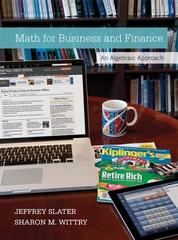



explanation needed in details(DON'T COPPY FROM OTHER SOURCES)
9. Assume that you plan to buy a share of XYZ stock today and to hold it for 2 years. Your expectations are that you will not receive a dividend at the end of Year 1, but you will receive a dividend of $9.25 at the end of Year 2. In addition, you expect to sell the stock for $150 at the end of Year 2. If your expected rate today? of return is 16 percent, how much should you be willing to pay for this stock a. $164.19 b. $75.29 c. $107.53 d. $118.35 e. $131.74 10. You have just purchased a 10-year, $1,000 par value bond. The coupon rate on this bond is 8 percent annually, with interest being paid each 6 months. If you expect to earn a 10 percent rate of return on this bond, how much did you pay for it? a. $1,122.87 b. $1,003.42 c. $875.38 d. $950.75 e. $812.15 11. The primary function of the money markets is to provide liquidity to businesses, governments, and individuals so that they can meet their short-term needs for cash. a. True b. False 12. The last dividend on Apple Bite's common stock was $4.00, and the expected growth rate is 10 percent. If you require a rate of return of 20 percent, what is the highest price you should be willing to pay for this stock? a. $44.00 b. $38.50 c. $40.00 d. $45.69 e. $50.00Questions.pdf - Adobe Acrobat Reader DC w Window Help Is FIN 3030 Bonus Q... x Q 11 / 29 6. A 12-year, semiannual coupon bond is priced at $1,102.60. The bond has a $1,000 face value and a yield to maturity of 5.33 percent. What is the coupon rate? 7. Best Western has $1,000 face value bonds outstanding. These bonds pay interest semiannually, mature in six years, and have a 5 percent coupon. The current price is quoted at 101. What is the yield to maturity? 8. Jeffries, Inc. has 6 percent coupon bonds on the market that have 11 years left to maturity. The bonds make annual payments. If the YTM on these bonds is 7.4 percent, what is the current bond price? 9. The 7.2 percent annual coupon bonds of IPO, Inc. are selling for $1,020. The bonds have a face value of $1,000 and mature in seven years. What is the yield to maturity? 10. A $1,000 face value bond is currently quoted at 99.8. The bond pays semiannual payments of $25.50 each and matures in five years. What is the coupon rate?1. Recall that the position, y(#), of the box can be described by the equation 1/"(t) + /(t) + 16.25y(t) = 0 Find the two values, A, and A2 that would ensure y(t) = e's or y(t) = ed' satisfies the equation above. (Hint: Use the Matlab command roots ([1 1 16.25]).) 2. Let v(t) := y'(t) be the velocity function. An alternative formulation of the equation in problem 1 is given by (81 = [-16.25 ] [28 Demonstrate that if then a(t) is a solution to the matrix equation above. (That is, show that if you multiply the matrix above by the vector r(t), the result is the vector [y'(t) v'(t)], where y(t) = edit and v(t) = Ajett.) 3. Given the vector valued function r(t) defined above, and the values of X, and 12 obtained in problem 1, what is lim |7(t) ||? 4. Confirm that if A is the matrix in problem 2, that is A = 0 -16.25 and j = 1,2,98 3 ARIMA Models To obtain the initial conditions, we use (3.48): (0) = by(1) + 0? [1 + 00 + 0'] and y(1) = $y(0)+020. Solving for y(0) and y(1), we obtain: (0) =2 1 + 206+ 92 and y(1) = 2 (1 + 80)(0 +9) 1 - 62 1 - 42 To solve for c, note that from (3.51), y(1) = co orc = y(1)/$. Hence, the specific solution for h 2 1 is = 02 (1 + 80)( + 8) 1 - 62 Finally, dividing through by y(0) yields the ACF P(h) = (1 + 80 )( + 0) 1 + 206 + 02 (3.52) Notice that the general pattern of p() versus / in (3.52) is not different from that of an AR(1) given in (3.8). Hence, it is unlikely that we will be able to tell the difference between an ARMA(1,1) and an AR(1) based solely on an ACF estimated from a sample. This consideration will lead us to the partial autocorrelation function














